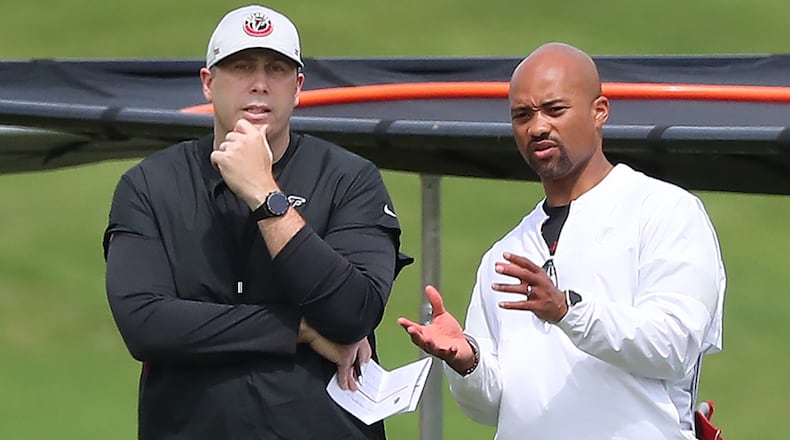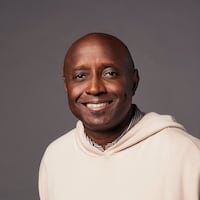I’m tired of writing about the Falcons’ offensive line. You’re probably tired of hearing about it. The team could end the discussion by finally fixing it. The old front office and coaching regime couldn’t do it before they were fired. The new one is off to a bad start.
The situation is more urgent than ever as the hits pile up on quarterback Matt Ryan, 36. The Falcons are committed to him for at least one more season, unless they decide to absorb some major salary-cap pain by parting ways. Statistically, Ryan is having one of his worst seasons. In context, Ryan has been pretty good, but the pass blocking has let him down.
The Falcons will have more salary-cap flexibility next offseason. They acquired an extra second-round pick for the 2022 draft in the Julio Jones trade. Adding a bona-fide pass blocker should be the top priority if they stick with Ryan. There are too many question marks about their young linemen, and too much at stake with Ryan’s health.
Ryan has been hit on 78 drop-backs this season, 20 more times than any other QB through Week 15. He was hit 70 times in 2020 (second most) and 62 times in 2019 (third most). Ryan has been hit more than any NFL quarterback over the past three seasons. The Falcons have been extraordinarily lucky that he’s remained durable.
Pass protection is not just about keeping Ryan healthy. It’s about winning. Doing it in the NFL requires passing the ball efficiently, explosively or both. The Falcons can’t do either so long as Ryan is dodging defenders in the pocket. Their deep passing game has been limited this season because they can’t risk letting Ryan hold the ball for long and possibly lose yardage (or the ball) on sacks.
Ryan’s production has decreased as his pass blocking has declined. He’s been pressured on 27.5% of his drop-backs this season, according to Pro Football Reference. That’s the third-highest pressure rate in the NFL through Week 15. Ryan faced the eighth-highest pressure rate in 2020 and ninth-highest in 2019.
Statistically, 2019-21 are Ryan’s three worst seasons since he established himself as a top-tier starter. In 2018, Ryan faced pressure on only 21.4% of his pass attempts, tied for ninth-best among qualified quarterbacks. His production that season looked a lot like his 2016 MVP campaign. Ryan had a career-high in yards per attempt in 2018 along with his second-best passer rating, touchdown total and completion percentage.
Maybe Ryan couldn’t produce like that anymore even if his pass protection holds up. I haven’t seen any evidence of serious decline. Decision-making, accuracy passing and leadership are the most important attributes for a quarterback. Ryan still checks all those boxes.
Ryan’s passes remain accurate. Per Pro Football Reference, his rates of on-target throws (11th-best this season among qualified quarterbacks) and bad throws (tied for seventh-best) are good. Ryan still gets the ball out on time and on target. The occasional poor, inexplicable decisions on red-zone throws are more than offset by his good choices.
Ryan’s pass protection has declined much faster than his ability. In 2018 the Falcons had one major weak link as a pass blocker, right tackle Ryan Schraeder. Attrition and mistakes in acquiring replacements over the years have reached the point where there’s mostly weak links along the line. The Falcons must fix that situation to have any hope of being a good team.
The challenge is that the Falcons must fix a lot of other things, too. That’s expected for a team that’s been outscored by 126 points through 14 games. The list of pressing needs includes good players at edge pass rusher, cornerback and wide receiver. I’d put an offensive lineman who can pass block near the top of the list, if not No. 1.
Everybody knew the Falcons needed better pass blocking this season. That includes general manager Terry Fontenot, who got the job in January. He had limited options because he inherited a roster lacking top-end talent and depth and had very little cap space. Fontenot’s most valuable asset was the No. 4 overall pick in the 2021 draft.
He could have used it on Penei Sewell, the top offensive lineman prospect. He’s played well at both tackle positions for the Lions, who are set to play the Falcons on Sunday at Mercedes-Benz Stadium. Detroit’s line was ranked 15th by Pro Football Focus after Week 14. The Falcons were 26th.
Selecting an offensive tackle near the top of the draft is common because it’s among the highest-valued positions. Fontenot instead made Kyle Pitts the highest-drafted tight end in NFL history. Pitts is having a very good rookie season. Maybe he will end up being the best tight end of all time.
But tight end ranks low in the pecking order of positional value. Maybe you view Pitts as more of a wide receiver, given how coach Arthur Smith lines him up across formations. Well, wide receiver is only a notch above tight end in value. And Pitts’ potential as a pass-catcher is tied to his team’s ability to protect the quarterback.
Fontenot’s selection of Pitts at No. 4 echoed his predecessor’s penchant for stacking up on skill players while neglecting to shore the line of scrimmage. The Falcons declined as their troubles blocking limited Ryan’s ability to get the ball to Jones and Co. Then the new, first-time GM came in and drafted a tight end with the team’s highest pick since Ryan was No. 3 in 2008.
Fontenot tried to address the offensive line later in the draft, where misses are more common. He picked Jalen Mayfield in the third round and Drew Dalman in the fourth. Mayfield started 15 games at right tackle for Michigan. He’s been overmatched in pass protection while starting at left guard for the Falcons. Dalman has played only 68 offensive snaps.
Young players have room to grow. The Falcons will have to be honest in their assessment of how much of it is possible for Mayfield, Dalman and second-year center Matt Hennessy. The jury is in on right tackle Kaleb McGary, who’s been a poor pass blocker over 42 career starts.
The Falcons signed a pair of veteran offensive linemen in the offseason, returning lineman Matt Gono and newcomer Josh Andrews. Injuries limited Andrews early in the season, but he hasn’t cracked the lineup since being healthy. Gono hasn’t played at all because of an undisclosed injury. Both players were stop-gap options, anyway, with one-year deals for a total combined salary of $4.3 million for 2021.
The Falcons need to invest more in Ryan’s pass blockers. It’s possible the market for free-agent linemen ends up being too hot for their cap space. If so, and the young guys they’ve drafted can’t do the job, then the Falcons need to admit it and take more cracks at offensive linemen in the next draft.
Just fix the pass blocking somehow, some way while Ryan still can play. Then we can finally stop talking about the Falcons’ bad offensive line.
About the Author
The Latest
Featured


